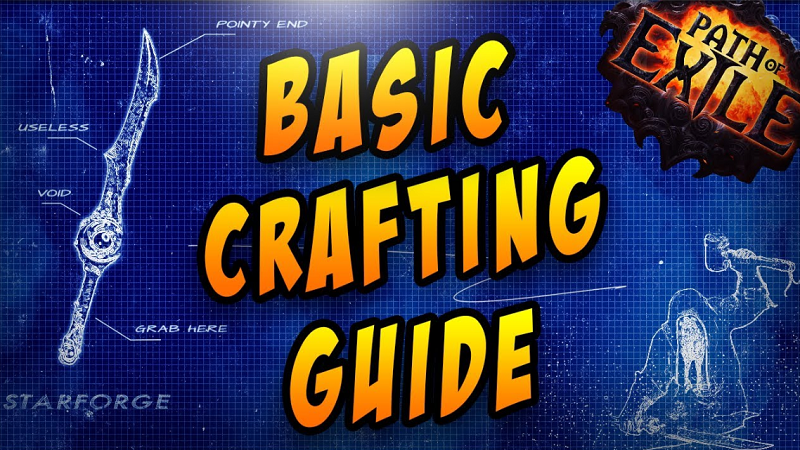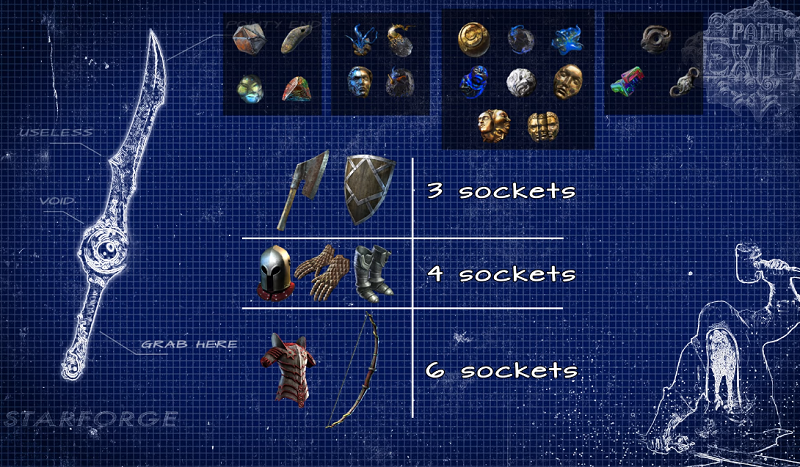It's been a few days since the Path of Exile 3.8 Blight League launch on all platforms, players may busy with various starter builds and maps shaping strategy for POE Blight. To get the desirable POE items, you need to craft or trade with others. Here goldkk.com brings a Path of Exile 3.8 crafting guide, aims to help beginners better understand the very basics of crafting. An excellent resource for new players, it covers concepts such as items' structure, affixes and their tiers, implicit mods, currency crafting, hideout crafting bench, beasts crafting and much more.

More Read: Path Of Exile 3.8 Blight Beginner Guide - Top 10 Tips & Tricks For POE Blight League Starters
Path Of Exile 3.8 Blight Crafting - Basic Crafting Guide For Blight League Beginners
POE crafting can be rather daunting but this guide will provide all the basic information you need to get started, help you better understand how to appraise the value of a POE item, progress through the game easier and faster and improve some of your existing gear.
With "Blight" 3.8 League is on the horizon, it is the perfect time to brush up on your core Path of Exile knowledge and greatly improve your Blight League start! Now check out the below methods for POE 3.8 Blight crafting!
POE 3.8 Blight Currency Crafting Guide - POE Currency, Orbs, Items Crafting Tips
The first and most obvious form of crafting is through the use of currency orbs. Apart from being used in all sorts of trading, each of these can transform items in a specific way. Of these, the most basic orbs are the ones affecting item quality.
- "Armourer's Scraps"are used on armour pieces and will increase the amount of evasion, energy shield or armour that the base provides.
- "Blacksmith's Whetstones" improve weapons' physical damage while Glassblower's Baubles increase the duration of flasks effects and buffs. All these currencies can add up to 20% quality to each item. When applied to white items the quality will increase by 5% with each orb, by 2% on magic items and finally by 1% on rares and uniques. As such, if your aim is to start crafting from a white base item, it's probably a good idea to use the quality orbs first.
- "Gemcutter's Prism" which increases the quality of skill gems. Since these cannot have different rarities, each prism raises quality by 1%. Every gem gains a different bonus from quality so you'll likely need to check the Path of Exile wiki page for the gems you want to improve to find out what you'll get.
The next category of orbs are the ones used to upgrade items from one rarity to another.
- First, there's the very basic and cheap “Orb of Transmutation” which upgrades a normal, white item, into a magic one and the resulting item will have one or two affixes.
- Then you have “Orbs of Alchemy”. These upgrade a normal item to a rare one with 4 to 6 affixes. A Regal Orb is used to upgrade Magic Items to rare ones by adding a single affix each time. Whatever mods the magic item had on it will be still present on the newly obtained item. This is a crucially different process than applying an Alchemy Orb because it allows you to more precisely control at least two affixes on the resulting rare item.
- Finally there's the “Orb of Chance” which transforms a white item into another random rarity. However do note that the probability to obtain a unique item is much lower than that of getting a magic one.
All these upgrade orbs will never change the item base, the quality, the item level or the implicit. So if you use an Alchemy Orb on a pair of Bronze Gloves with 5% quality and item level 25, the result will be rare Bronze gloves with 5% quality and item level 25. This has some pretty important implications for crafting.
The next category of orbs are the ones that add, remove or modify existing mods in certain ways.
- “Blessed Orbs” are used to re-roll the numeric value of implicit mods on items that have one and they work on all rarities, including unique items. These are relatively cheap so they're really useful for min-maxing your gear and squeezing out something like a few more resistance points or life from items with implicits.
- Then there's the “Orb of Augmentation” which adds an additional affix to a magic item that only had a single one.
- “Orbs of Alteration” will re-roll a magic item for a new set of random affixes. The result is completely random and whatever affixes were previously on the item have no impact on the outcome. And you can even get the exact same affixes again, it's not common but it happens.
Since they're relatively cheap, orbs of Transmutation, Augmentation and Alteration are very often used together to create a magic item with one or two very good affixes. You start off with an appropriate base for your target craft, keeping in mind the required minimum item level and whether or not it needs to be a Shaper or Elder item. Improving quality at this point is recommended if the item supports it and you're not crafting something like a jewel. Then upgrade the normal item to a magic one with a Transmutation Orb.
- The alternative is to use a “Regal Orb” on it which will add one additional affix and transform it into a rare item, while of course retaining the two existing mods. The chances to get a good, high tier affix with the Regal Orb are quite slim, but it can happen and in such cases the item's value has increased tremendously. However, more often then not you'll get a bad affix, as it happened here.
- In that situation you can use an “Orb of Annulment”, a rare and quite expensive piece of currency. This randomly removes one affix from an item so in a scenario where you have two great mods and a bad one, there's 1 in 3 chances to be left with two good affixes. If you're lucky and you remove the shit mod, you now have an even more valuable item than it was before upgrading from magic to rare. At that point it can either be sold or further crafted using some more advanced methods.
- “Orbs of Scouring” will remove all affixes from an item and will thus turn it into a white rarity one. It does not however affect the items' quality, implicit, enchants, sockets or links.
- The final piece of currency used to manipulate item mods is the “Chaos Orb”. It’s simply reroll all the affixes on a rare item, both tiers and numeric values. It's an almost complete randomization of the item and as such the results are always unpredictable. It's generally used on items which can roll a wide variety of useful affixes in a large number of combinations. Jewels, rings, amulets, maps, strongboxes, these are generally good options for chaos spamming. You can get lucky and roll a decent enough item.
The last category of POE 3.8 Blight item crafting currency is comprised of orbs that affect sockets and links.

As you've likely found out from the first minutes of gameplay, most items in Path of Exile can have sockets where you can put skill gems. These sockets can in turn be linked allowing the gems you put inside to influence each other in certain ways. The maximum number of sockets on any particular piece of gear depends on the item type. 1-handed weapons and shields can have up to 3 sockets, helmets, gloves and boots up to 4 and body armour as well as 2-handed weapons a maximum of 6 sockets. Using “Jeweller's Orbs” on an item will re-roll the number of sockets it has, within the limitations.
Path Of Exile 3.8 Blight Crafting Guide - POE Hideout Crafting Bench crafting tips
Apart from using standard currency, there's one additional basic crafting method that I'll be covering in this guide: the hideout crafting bench.
After completing a quest in Act 2, the NPC Helena will grant you access to your own hideout. And probably the most important functionality for this area is the crafting bench. This can normally be used to add a single affix on a magic or rare item which has less than max. By default the bench comes with a few basic recipes but you can find more by completing various types of content. Some can be found after unveiling items dropped by Syndicate members, others at certain depths in the Delve mine, while more esoteric ones in Incursion Temple rooms or after completing prophecies. While the affixes you can add this way have lower values than the naturally rolled ones, they are still great ways of improving your gear for a low cost. Also, unlike the almost complete randomness of currency orbs, the crafting bench provides some degree of control and flexibility in customizing at least one affix on your items.
Crafting bench has a lot of other functionalities such as meta-mods, manipulating sockets and links, crafting corrupted items and so on. And there are of course quite a few other POE Blight crafting methods, each with its own functionalities, and all can be combined with the basic methods to achieve different results.
Path Of Exile Blight Beasts Crafting Tips
When it comes to POE 3.8 Beast crafting, a lot of beasts have very situational uses and can be much cheaper options for crafting, save you some exalts and make you even more.
- Flask Crafting: Why it's not a hugely profitable venture early season, this will get you the exact mods you need and it only uses rare beasts these require flasks to have an open suffix, the useful ones are flasks of warding which removes curses, flasks of heat which makes you immune to freeze, the flask of stonking which removes bleeding and his must-have for most builds.
- Aspect Crafting: It's a cornerstone to be scrapped, there are four types of aspects kills, the avian, the cat, the crab and the spider. All of these give you a buff and reserve a percentage of your mana, you can get these from specific uniques or you can actually be scrapped. These abilities on rare items, these take up a suffix on an item and can range in value depending on the league normally with spider and cat being at the high end. If you have an item with 4 mods and an open suffix consider throwing an aspect on it to raise its value, before you do this make sure the aspect you craft will help the build. The item is being made for.